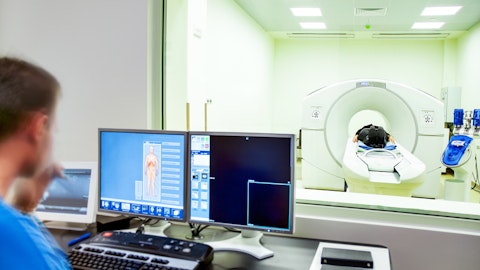Mike Matson: Yes. Thanks. Just want to follow-up on that question about the 1,200 customer accounts. How many of those were not previously number of customers?
Adam Elsesser: Yes. That’s actually a great question. I don’t – I can’t with the exact specificity give you that number. I can tell you that I know that way more than half, the majority of those 650 accounts and the majority of the following 600 are our new customers. There might be a handful of existing customers in there, but the vast majority are new customers.
Mike Matson: Okay. Thanks. And then the one thing that surprised us in ‘23 was just the strength on the neuro side. I mean clearly, vascular it looked like it was going to do well given the product cycle. But Thunderbolt has been delayed. So, what I am wondering is looking into next year, do you have anything new coming in neuro to kind of help drive the growth there in ‘24?
Adam Elsesser: Yes. I will start with – we always have new products in both fields, neuro as well. I am not going to comment on them. The core technology is right now, RED 72 with SENDit, which it’s got a long way to go to continue to drive growth. We are continuing to just as we – I heard of a physician who had tried it, who typically hadn’t been using our aspiration catheters and was particularly blown away by how well it attract. So, I think we won yet another customer over. So, that’s going to drive our success for a while because, again, if you can’t get the catheter there, then Thunderbolt doesn’t matter. You have to have it be so easy to get there that you are excited to use Thunderbolt. So, I think the timing on Thunderbolt is really sets us up so that we can use the time next year to really continue to get in to more and more accounts, which as you said, we have done pretty well this year.
We have taken back significant share, as I said in my prepared remarks, we now in our estimate, over 55% of the stroke aspiration catheter market. And that’s – it’s kind of a notable thing that we are competing with 28 other catheters. So, usually, when you have that many products all competing, you don’t have a dominant player, if you will. And the fact that we are is a testament to the success we have had this year with RED 72 and SENDit, and I don’t think that will stop and I think we will continue with that.
Jason Mills: Yes. Mike, good question. The only thing I would add, this is Jason, is you saw with SENDit, the U.S. stroke business have another really strong quarter, double-digit growth this quarter, 20%. And as you know, we don’t have yet that product launching anywhere outside the U.S. The other thing I would just note is you are hearing us talk about thrombectomy globally, which includes stroke, obviously, be thrombectomy head to toe vis-à-vis the embolization and access businesses. So, I think what you are going to see – continue to see is thrombectomy, including stroke, but obviously, vascular thrombectomy as well lead our growth. So, just pointing that out as you are asking about neuro versus vascular, I think what we are talking about more is thrombectomy vis-à-vis embolization and access.
Mike Matson: Perfect. Got it. Thank you.
Operator: Your next question comes from the line of Matthew O’Brien. Your line is open.
Unidentified Analyst: Hi. Thank you. This is Samantha on for Matt. Just a couple from us, and I guess first on the expected robust growth for thrombectomy, I know you said 40%. How much could you attribute that to maybe an easier pre-flash comp versus expectations for sequential growth?
Jason Mills: Yes. So, it’s a very good question. Thank you for it. We continue to expect very good sequential growth as well. Comps aside, we are growing significantly faster regardless than I think folks expected in thrombectomy generally, and of course, relative to the market. That’s happening both year-over-year and sequentially.
Unidentified Analyst: Okay. Thank you. And also a question about the VACS, thank you for all the details there. I was wondering, could you provide any more detail on maybe how many of those facts are kind of double counted for both flash and bolt versus a single flash or just a single bolt.
Adam Elsesser: Yes. So, that’s a really good question, and I apologize for maybe not clarifying. The way we talk about them is each one is a separate accounts. So, there – it’s possible, for example, that in the 650 accounts that I have said have gotten back approval, but have not yet ordered because they are going through the supply chain process and will soon. Of those, you might have one hospital, but two – I count it twice because it’s bolt and flash. And sometimes, the same physician is using both products. But in other times, they are not because, as you know, there is interventional cardiologists, vascular surgeons and interventional radiologists who share this and some specialize in certain parts of the body and others don’t.
So, many of those that have one hospital, but two submissions, it’s separate people who are advocating for those products. It’s just a different process. So, it’s not all lumped in as one, and that’s why we count them separately.
Operator: [Operator Instructions] Our next question comes from the line of David Rescott. Your line is open.
David Rescott: Hey guys. Thanks for taking the questions. I just wanted to start maybe on the neuro thrombectomy segment. I think maybe the comps there were a little bit tougher year-over-year and the numbers came in a little bit below maybe what we were expecting, obviously higher on the peripheral vascular side. But just wondering if there is anything you would want to call out just on the neuro thrombectomy. Sir, I know you talked about SENDit, getting into a position of expanding the market, taking share, maybe having a little pricing benefit there. But just wondering on a cadence basis, year-over-year sequentially, if there is any color you can provide there.
Jason Mills: Yes. Thanks David. This is Jason. So, our neuro business achieved our expectations for the quarter, and the team really executed quite well, especially in the United States. So, in the United States, the neuro franchise grew 17% year-over-year. I think we have been articulating from the beginning of the year that we expected our vascular business to grow above our total company guidance range, which of course has come up from $1 billion to where it is today throughout the year. And we said neuro would grow below this range. Since we don’t give specific guidance by franchise, I think generally, models may have not accounted for this guidance, perhaps because the neuro growth was higher in the first half of the year.
But we fully anticipated neuro growth internationally in the second half of the year would face more seasonality and lower growth in some distributor markets, which is why we gave the guidance context at the beginning of the year that we did. So overall, we are quite proud of the progress in our neuro business and continue to expect the new products we have with SENDit and Thunderbolt eventually will fuel our future growth.
David Rescott: Okay. Great. Helpful. And then maybe just sticking on that point, taking a step back longer term, I know that newer products put you in the share gain position. When we think about just the overall maybe either U.S. or worldwide neuro thrombectomy market, I know maybe earlier in the year, we saw kind of some of these trials reading out in thrombectomy specifically about maybe expanding the market towards some of the large core in size patients, more distal occlusions. Just wondering from a higher level, more macro perspective, if the neuro thrombectomy market itself, Penumbra is reaccelerating expanding or if those are opportunities to drive further growth going forward.




